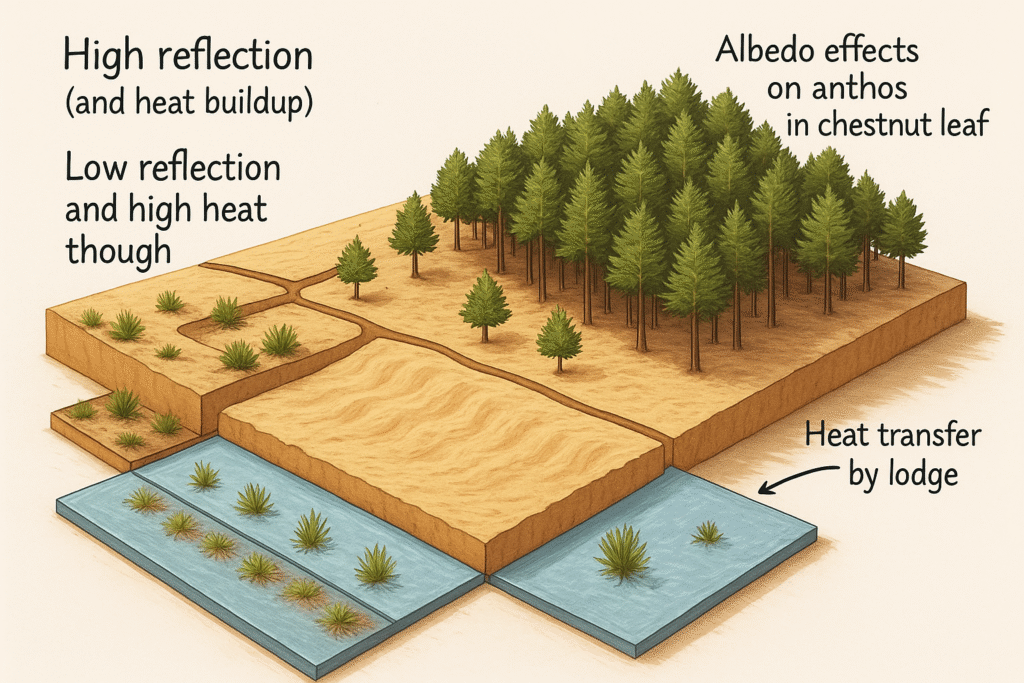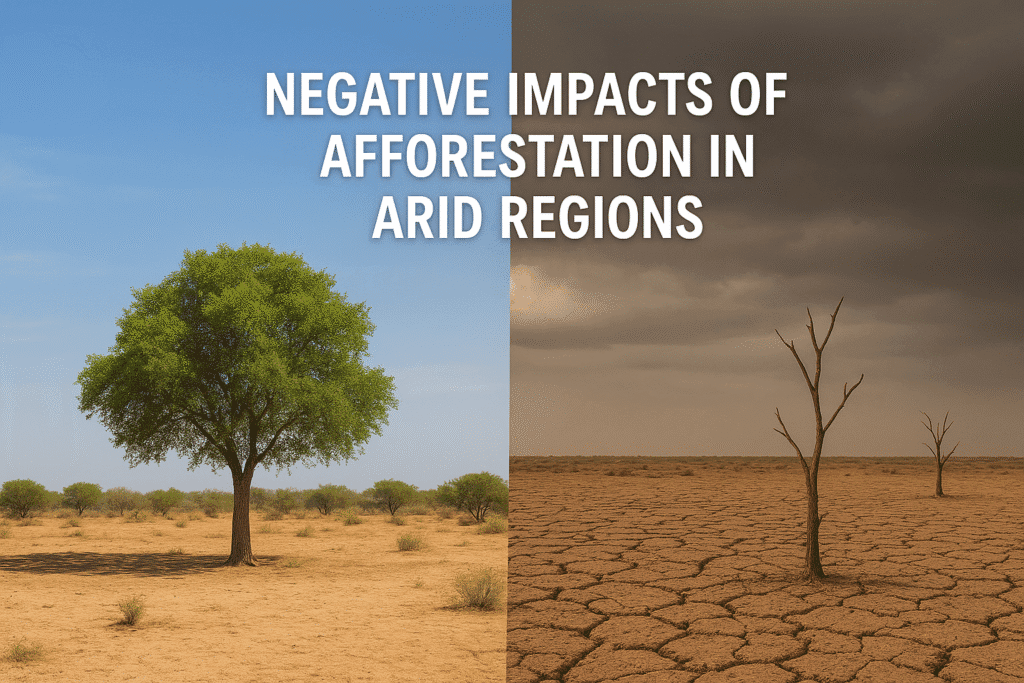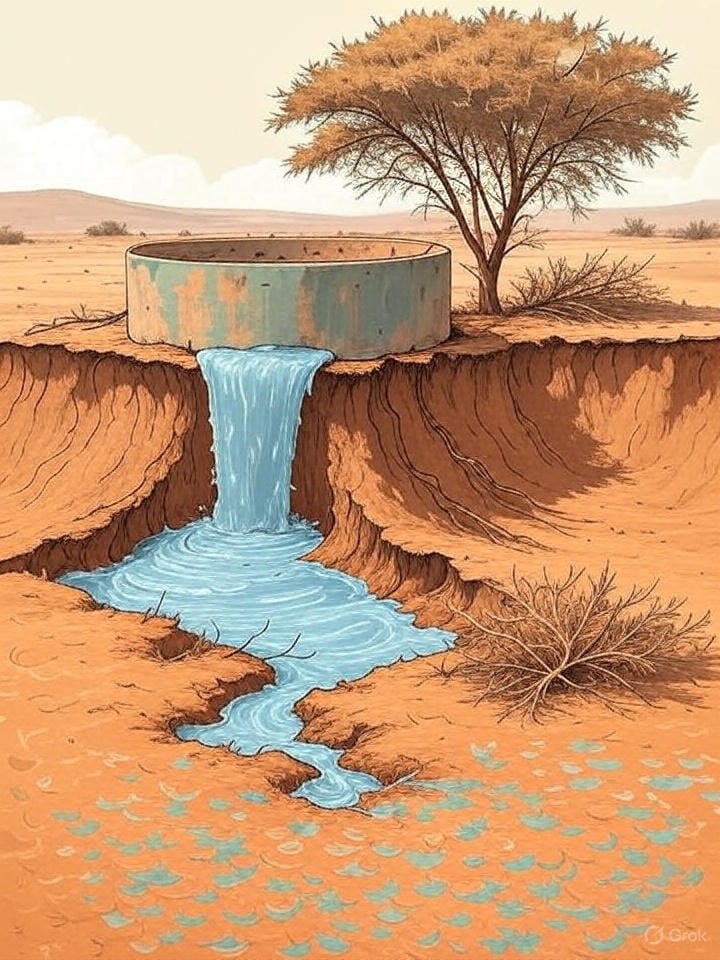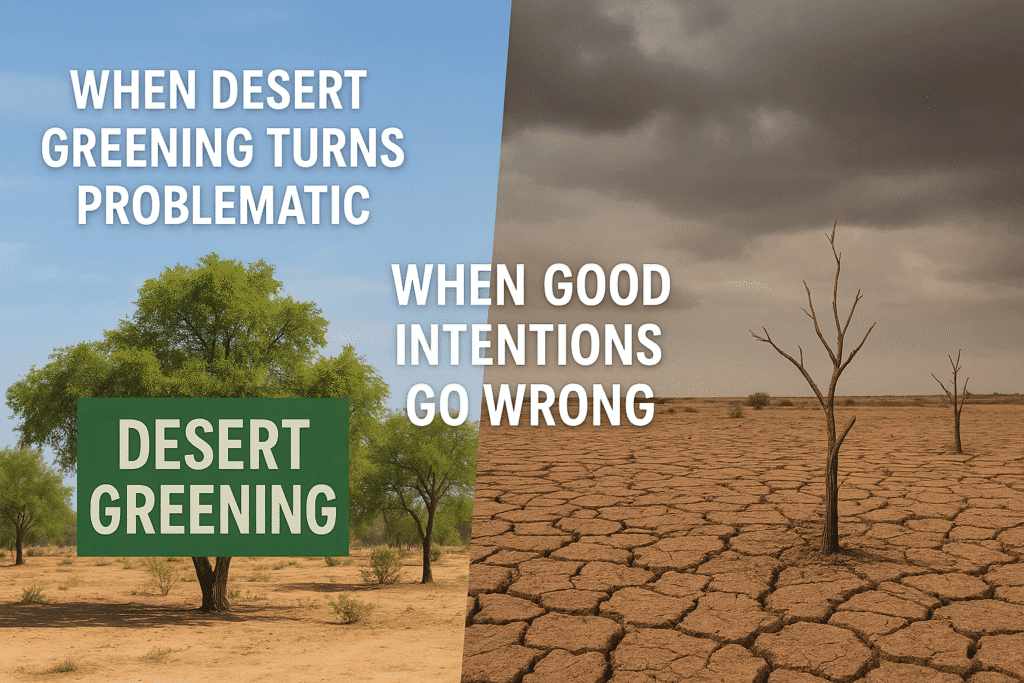
Table of Contents
ToggleWhen desert greening turns into problem
Global campaigns have promoted planting trees in deserts as a bold answer to climate change and land degradation over the years. China has implemented the green belt strategy very effectively in its deserts. Images of green belts cutting across barren landscapes spark hope and inspire the Government and NGOs to launch massive projects. Throughout the article we will see why planting trees in deserts fails and its negative impacts.
Yet the reality on the ground often tells a different story. Why planting trees in deserts fails isn’t always about poor intentions, it’s about the harsh truths of ecology. Arid zones have evolved over millennia to survive with minimal water and unique vegetation. Introducing water-hungry species can disrupt this fragile balance, draining scarce groundwater and altering soil chemistry. In many cases, saplings fall under relentless heat, and at last, those species that survive become long-term water consumers. Instead of reversing desertification these efforts damage native biodiversity and deepen water crisis.
Why planting trees in deserts fails ?
The afforestation idea which is to turn a barren wasteland into a thriving forest appears to be seductive. Through it we can lock away carbon and restore life where there’s only dust. But deserts aren’t Empty canvases that are waiting for trees. They are ancient systems which is perfectly adapted to survive with very little water, extreme heat and its scarce nutrients. Introducing trees without deep ecological planning often sparks a cascade of unfavorable results. Tree planting in desert often fails but shrubs can easily survive.
1. Severe Water Deficit
Young trees are like infants – they demand constant care and hydration. In deserts, you can only meet these demands by pumping groundwater or diverting precious river flows. This extraction does not just stress the water table, it also competes directly with human drinking needs and agriculture. In some regions desert afforestation has accelerated Aquifer depletion that pushes communities closer to water crisis. Desert planting has a lot of impact on water.
2. High Mortality Rates
Even the hardest sapling struggles under relentless sunlight, scorching winds, and nutrient-poor soils. Survival rates can drop below 20% in the first year without consistent irrigation. Replanting drives quickly become a cycle of planting and perishing. It consumes labor, money, and public trust with little lasting greenery to show for it.
3. Displacing the Desert’s true residents
Deserts are included with those life that are uniquely adapted to scarcity: hardy shrubs, low-lying grasses, and specialized wildlife. Planting dense tree cover shades over these uniquely adapted plants results in changes in wind patterns and also alters seed dispersal routes. When the native species vanish – insects, birds, and mammals that depend on them also disappear, and at last biodiversity collapses.
4. Soil chemistry changes
Desert soils are often alkaline, mineral-rich, and biologically stable. During afforestation, rich minerals turn into an imbalance. Fallen leaves from New tree species can acidify the soil, trap moisture in unnatural ways and encourage invasive pests or fungi. Over time, the ground shifts from being desert-adapted to something weird.
5. Long-term water drainage
Even so-called drought-tolerant trees consume far more water than native desert flora. Once they are mature their deep roots can tap into and steadily drain underground reserves that took centuries to accumulate. The full impact might not be visible for decades until Wells become dry and once-reliable springs disappear.
That’s why planting trees in deserts fails without matching species, water availability, and ecological function is like building a mansion without a foundation. It might look good at first but at last it will collapse under its own contradiction.

Negative Impacts of Afforestation in arid regions
Afforestation in deserts is often marketed as a climate hero but on the ground it can act more like an ecological disruptor. Beyond the immediate failures of survival, these large-scale tree plantings in arid lands trigger deep and long-term changes that reshape the land, water, and wildlife.
1. Groundwater Depletion – Trees in deserts don’t just sil water they also pull it r relentlessly from underground reserves. In some cases aquifers that once supplied villages and oases for centuries have dropped dramatically after establishment of nearby plantations.
2. Biodiversity loss – Native plants like xerophytic shrubs and desert grasses are not just decoration they are the base of a web supporting insects, reptiles, birds and mammals. Dense tree cover shades them out and forces wildlife to abandon the area.
3. Soil Erosion and compaction – heavy irrigation and machinery used in planting often disturb fragile desert crusts. This crush acts as a natural erosion barrier. Once it is broken wind and flash floods strip away valuable topsoil.
4. Microclimate alterations – introducing dark tree canopies in light-coloured desert landscapes results in lower albedo, more heat absorption, and sometimes raises local temperature rather than cooling them.
5. Risk of Invasive species – non native trees can spread beyond planting zones. Their expansion results in high competition with local vegetation and it also alters entire landscapes. This is called a slow-moving invasion that’s hard to reverse.
In short, afforestation in arid regions isn’t just a gamble with water, it’s a roll of the dice with the entire ecosystem at stake. These gambling practices are the reason why planting trees in deserts fails. Sustainable desert management must work with native systems.

Do desert trees Increase water scarcity ?
The biggest misconception about desert tree planting is that more greenery means more water. In reality, trees in arid environments often act as net water consumers, pulling from reserves faster than nature can replenish them. Let’s see deeply :-
1. Deep-rooted water mining – Desert-adapted shrubs and grasses have shallow root systems, which allow them to take advantage of short bursts of rain. Many introduced tree species develop deep roots that tap into ancient aquifers and drain water that may have taken centuries to form.
2. High transpiration Rates – Trees in hot & dry climates lose large amounts of water through their leaves. This process not only depletes their own reserves but also increases atmospheric dryness and intensifies drought conditions.
3. Competition with Communities – In regions where water is already rationed, these large-scale plantations divert irrigation and groundwater away from drinking supplies and agriculture.
4. Seasonal Mismatch – some none native trees continue to draw water year-round even during the driest months when natural vegetation remains dormant. This constant demand destabilizes the delicate water balance of desert ecosystem.
According to the U.S. Geological Survey, only about half of the water used for irrigation is reusable. Observation from Sahel, the Middle East, and parts of western China reveals a consistent trend that, without strict water budgeting and native species selection, desert tree planting accelerates water scarcity rather than easing it. What was meant to heal the land can even quietly drain its lifeblood.

Sahel Greening project controversy
We know why planting trees in deserts fails and all those steps were followed by sahel projects. The great green wall became a global symbol of hope for the Sahel. It was an iconic tree belt that promised to halt desertification, anchor soils, and lift livelihoods. But On the ground the reality has been uneven, it has resulted in a patchwork of bright spots, stalled plots and hard lessons that rarely allow it to be published by presses.
How did the Sahel Green Project fail?
Centralised planting quotas often ignore local rain patterns, soil types, and land use traditions. Communities were asked to maintain those trees that were not chosen by them, and hence they couldn’t water them. Another reason is – species mismatch. Fast growing or non native trees looked good for quick wins but struggled against heat, pests and shallow soils. Many sites became “replanting loops” rather than functioning woodlands.
Water arithmetic failure was 3rd reason for afforestation failure. Seedling drives rarely came with long-term water budgets. Wells dropped, irrigation costs rose and the competition for needs like drinking, livestock and crops created conflicts. Plantations overlapped human routes and communal grazing lands, which later sparked disputes with pastoralists and reduced rangeland flexibility.
Monitoring in a way that counts trunks rather than outcomes. Success was measured as seedlings planted, not canopy surviving, groundwater stabilization or income improvements. The last reason in my opinion is Short funding cycles . Projects raced to plant before grant deadlines then faded during the slow & unglamorous years of weeding, fencing and protection.
What lessons were learnt by Sahel Green Project
- Water should be first and trees should be second. It’s important to lock a micro hydrology and a realistic water budget before making a single hole.
- Right plant in right place with right density. We should always prefer native & multi-beneficial species. Keep spacing should be aligned with rainfall and soil depth.
- Always protect what already wants to grow- The most deserving one is always ignored. Start with FMNR; plant only to fill functional gaps.
- Plan for people and herds. Always map corridor, tenure and seasonal uses. We must build flexible grazing agreements.
- Always measure survival and services not ceremonies. Track 3-5 years of survival, soil moisture, groundwater trends and household benefits.
- Fund maintenance rather than just planting. Budget for fencing, weddings, and community guards should be arranged anyhow during the early years.
Faqs
Why planting trees in deserts fails despite of good intentions?
Here’s why planting trees in deserts fails :-
- These ecosystems are adapted to extreme water scarcity, high temperatures and specialised native vegetation
- Introducing water-hungry trees that disrupt this balance and lead to groundwater Depletion, soil chemistry changes & loss of native biodiversity.
- Without precise species selection and sustainable water management, survival rates remain low and long-term damage can occur.
Why planting trees in deserts fails to stop desertification?
Desertification is not just lack of trees it’s a complex process which involves soil degradation water scarcity and climatic extremes. Large-scale tree planting in arid regions can actually worsen the problem if non native species are used. Irrigation drains aquifers or land use conflicts may also arise. Restoring native vegetation and managing water wisely are more effective strategies.
Why planting trees in deserts fails without local community involvement?
Tree planting projects in the desert need ongoing care, protection, and water management. Without local community involved in planning and stewardship survival rates would be very low. Community-led approaches like farmer-managed natural regeneration (FMNR) and native species planting ensure better adaptation to long-term maintenance,ce, and shared benefits, which overall reduces the risk of project collapse.
